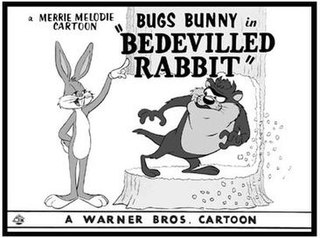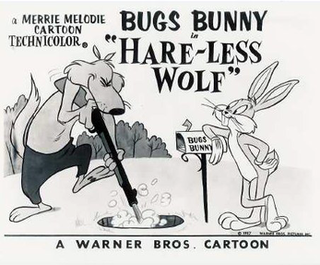
Bugs Bunny is a cartoon character created in the late 1930s at Warner Bros. Cartoons and voiced originally by Mel Blanc. Bugs is best known for his featured roles in the Looney Tunes and Merrie Melodies series of animated short films, produced by Warner Bros. Earlier iterations of the character first appeared in Ben Hardaway's Porky's Hare Hunt (1938) and subsequent shorts before Bugs's definitive characterization debuted in Tex Avery's A Wild Hare (1940). Bob Givens, Chuck Jones, and Robert McKimson are credited for defining Bugs's design.

Daffy Duck is a cartoon character created by animators Tex Avery and Bob Clampett for Leon Schlesinger Productions. Styled as an anthropomorphic black duck, he has appeared in cartoon series such as Looney Tunes and Merrie Melodies, in which he is usually depicted as a foil for either Bugs Bunny, Porky Pig or Speedy Gonzales. He was one of the first of the new "screwball" characters that emerged in the late 1930s to replace traditional everyman characters who were more popular earlier in the decade, such as Mickey Mouse, Porky Pig, and Popeye.

Yosemite Sam is a cartoon character in the Looney Tunes and Merrie Melodies series of short films produced by Warner Bros. His name is taken from Yosemite National Park in California. He is an adversary of Bugs Bunny and his archenemy alongside Elmer Fudd. He is commonly depicted as a mean-spirited and extremely aggressive, gunslinging outlaw or cowboy with a hair-trigger temper and an intense hatred of rabbits, Bugs in particular. In cartoons with non-Western themes, he uses various aliases, including "Chilkoot Sam" and "Square-deal Sam" in 14 Carrot Rabbit, "Riff Raff Sam" in Sahara Hare, "Sam Schultz" in Big House Bunny, "Seagoin' Sam" in Buccaneer Bunny, "Shanghai Sam" in Mutiny on the Bunny, "Von Schamm the Hessian" in Bunker Hill Bunny, "Baron Sam von Schpamm" in Dumb Patrol, and many others. During the golden age of American animation, Yosemite Sam appeared as antagonist in 33 animated shorts made between 1945 and 1964.

Knighty Knight Bugs is a 1958 Warner Bros. Looney Tunes cartoon directed by Friz Freleng, The short was released on August 23, 1958, and stars Bugs Bunny and Yosemite Sam.

Porky's Hare Hunt is a 1938 Warner Bros. Looney Tunes animated short film directed by Ben "Bugs" Hardaway and an uncredited Cal Dalton, which stars Porky Pig as a hunter whose quarry is a little white rabbit. The short was released on April 30, 1938.

False Hare is a 1964 Warner Bros. Looney Tunes animated short directed by Robert McKimson. The short was released on July 18, 1964, and stars Bugs Bunny.

Ballot Box Bunny is a 1951 Warner Bros. Merrie Melodies theatrical cartoon short directed by Friz Freleng and written by Warren Foster. The cartoon was released on October 6, 1951, and features Bugs Bunny and Yosemite Sam.

Hair-Raising Hare is a Warner Bros. Merrie Melodies cartoon, released on May 25, 1946. It was directed by Chuck Jones and written by Tedd Pierce. It stars Bugs Bunny and features the first appearance of Chuck Jones' orange monster character "Gossamer".

Little Red Riding Rabbit is a 1944 Warner Bros. Merrie Melodies cartoon, directed by Friz Freleng, and starring Bugs Bunny. It is a sendup of the "Little Red Riding Hood" story, and is the first time in which Mel Blanc receives a voice credit.

The Looney Looney Looney Bugs Bunny Movie is a 1981 American animated comedy package film with a compilation of classic Looney Tunes/Merrie Melodies Warner Bros. cartoon shorts and animated bridging sequences produced and directed by Friz Freleng, hosted by Bugs Bunny. The new footage was produced by Warner Bros. Animation. It was the first Looney Tunes/Merrie Melodies film with a compilation of classic cartoon comedy shorts produced by Warner Bros. Animation.

Three Little Bops is a 1957 American animated musical comedy film, directed by Friz Freleng and written by Warren Foster. A takeoff on The Three Little Pigs told as a hip, jazzy musical, the short features the voice of Stan Freberg, with music provided by jazz composer/trumpeter Shorty Rogers. It was released by Warner Bros. Pictures on January 5, 1957 as part of the Looney Tunes series.

Hare Remover is a Merrie Melodies cartoon starring Bugs Bunny and Elmer Fudd, released in 1946. The film was the second Bugs Bunny cartoon to be directed by Frank Tashlin, the first being The Unruly Hare (1945).

Bedevilled Rabbit is a 1957 Warner Bros. Merrie Melodies short directed by Robert McKimson. The short was released on April 13, 1957, and stars Bugs Bunny. In this cartoon, Bugs is lost in Tasmania, and has to deal with the Tasmanian Devil.

Looney Tunes Golden Collection: Volume 5 is a Looney Tunes collection on DVD. Following the pattern of one release each year of the previous volumes, it was released on October 30, 2007.

To Hare is Human is a 1956 Warner Bros. Merrie Melodies cartoon directed by Chuck Jones. The short was released on December 15, 1956, and stars Bugs Bunny and Wile E. Coyote. In this film, Wile builds a UNIVAC computer, and grows to rely on its answers.

Elmer J. Fudd is an animated cartoon character in the Warner Bros. Looney Tunes/Merrie Melodies series and the archenemy of Bugs Bunny. His aim is to hunt Bugs, but he usually ends up seriously injuring himself and other antagonizing characters. He lisps, replacing his Rs and Ls with Ws, so he often refers to Bugs Bunny as a "scwewy" (screwy) or "wascawwy (rascally) wabbit". Elmer's signature catchphrase is, "Shhh. Be vewy vewy quiet, I'm hunting wabbits", as well as his trademark laughter.

The Iceman Ducketh is a 1964 Warner Bros. Looney Tunes theatrical cartoon directed by Phil Monroe and Maurice Noble, with a story by John W. Dunn. The short was released on May 16, 1964, and stars Bugs Bunny and Daffy Duck. It was the penultimate Warner Bros. Theatrical Cartoon to feature Bugs Bunny and the last Warner Bros. theatrical cartoon to feature Bugs and Daffy together until Box-Office Bunny in 1991, and the last that the Chuck Jones unit worked on, though Chuck Jones himself was fired at an early stage of production and replaced by Monroe.
The character that would evolve into Bugs Bunny appeared in four cartoon shorts before his first official appearance in Tex Avery's A Wild Hare. While this early version is commonly referred to as "Happy Rabbit", animation historian David Gerstein disputes this, saying that the only usage of the term was from Mel Blanc himself; the name "Bugs Bunny" was used as early as April 1938, from a model sheet made by Charles Thorson which was used for the short Hare-um Scare-um. Bugs was also mentioned by name from an August 1939 review of the short in the Motion Picture Herald.

Hare-Less Wolf is a 1958 Warner Bros. Merrie Melodies cartoon directed by Friz Freleng. The short was released on February 1, 1958, and stars Bugs Bunny.


















